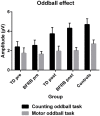The Impact of a Cognitive-Behavioral Therapy on Event-Related Potentials in Patients with Tic Disorders or Body-Focused Repetitive Behaviors
- PMID: 27242551
- PMCID: PMC4861894
- DOI: 10.3389/fpsyt.2016.00081
The Impact of a Cognitive-Behavioral Therapy on Event-Related Potentials in Patients with Tic Disorders or Body-Focused Repetitive Behaviors
Abstract
Context: Tic disorders (TD) are characterized by the presence of non-voluntary contractions of functionally related groups of skeletal muscles in one or multiple body parts. Patients with body-focused repetitive behaviors (BFRB) present frequent and repetitive behaviors, such as nail biting or hair pulling. TD and BFRB can be treated with a cognitive-behavioral therapy (CBT) that regulates the excessive amount of sensorimotor activation and muscular tension. Our CBT, which is called the cognitive-psychophysiological (CoPs) model, targets motor execution and inhibition, and it was reported to modify brain activity in TD. However, psychophysiological effects of therapy are still poorly understood in TD and BFRB patients. Our goals were to compare the event-related potentials (ERP) of TD and BFRB patients to control participants and to investigate the effects of the CoPs therapy on the P200, N200, and P300 components during a motor and a non-motor oddball task.
Method: Event-related potential components were compared in 26 TD patients, 27 BFRB patients, and 27 control participants. ERP were obtained from 63 EEG electrodes during two oddball tasks. In the non-motor task, participants had to count rare stimuli. In the motor task, participants had to respond with a left and right button press for rare and frequent stimuli, respectively. ERP measures were recorded before and after therapy in both patient groups.
Results: CoPs therapy improved symptoms similarly in both clinical groups. Before therapy, TD and BFRB patients had reduced P300 oddball effect during the non-motor task, in comparison with controls participants. An increase in the P300 oddball effect was observed posttherapy. This increase was distributed over the whole cortex in BFRB patients, but localized in the parietal area in TD patients.
Discussion: These results suggest a modification of neural processes following CoPs therapy in TD and BFRB patients. CoPs therapy seems to impact patients' attentional processes and context updating capacities in working memory (i.e., P300 component). Our results are consistent with a possible role of the prefrontal cortex and corpus callosum in mediating interhemispheric interference in TD.
Keywords: Tourette syndrome; body-focused repetitive behaviors; cognitive–behavioral therapy; cognitive–psychophysiological therapy; electrophysiology; event-related potentials; habit disorder; tic disorders.
Figures




References
LinkOut - more resources
Full Text Sources
Other Literature Sources
Miscellaneous

